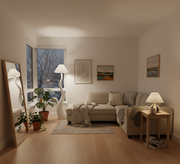You moved into a beautiful Montreal condo or Toronto apartment, unpacked your dining table, and looked up—nothing. No overhead light. No junction box. Just a blank ceiling and the faint hum of developer budget cuts echoing through the concrete slab above.
You’re not alone. Thousands of Canadian renters and condo owners face the same challenge: dining areas designed without hardwired ceiling fixtures. The good news? You don’t need an electrician or landlord approval to create warm, functional dining light. A smart mix of floor lamps and table lamps—placed with intention—can deliver the same ambience and brightness as a chandelier, with zero drilling.
This guide walks you through nine field-tested layouts, exact brightness targets, and the bulb specs that matter for dinner lighting in Canadian homes.
Jump to:
- Why Many Canadian Dining Areas Lack Overhead Lights
- 9 Layouts That Work (No Hardwiring)
- How Bright Should It Be? (Simple Math)
- Bulbs, Colour Temperature & Dimmers
- Quick Checklist Before You Buy
- Shade Shapes vs Glare Control
- FAQ
- Make Your Dining Area Glow
Why Many Canadian Dining Areas Lack Overhead Lights
Developer cost-cutting: Pre-wiring ceiling boxes adds labour and materials. In condo buildings where margins are tight, dining areas often get skipped—especially in open-concept layouts where the “dining zone” is just a designated corner of the living room.
Concrete ceilings: Poured concrete slabs make retrofitting electrical boxes expensive and disruptive. If the builder didn’t plan for it during framing, adding a ceiling fixture later means chiselling, conduit work, and strata/condo board approvals.
Rental restrictions: Even if you own your unit, many condo declarations prohibit ceiling penetrations without engineer sign-off. Renters face even stricter rules—no hardwiring, period.
The result? A blank ceiling and a plug-in challenge. Fortunately, floor and table lamps have evolved. Modern LEDs deliver the lumens you need, dimmers give you control, and thoughtful placement solves the coverage problem.
9 Layouts That Work (No Hardwiring)
Each layout below includes placement measurements, bulb guidance, and an anti-glare tip. Choose based on your room shape, furniture arrangement, and whether you’re aiming for intimate dinners or brighter multifunction use.
1. Sideboard Stack
When to use: You have a sideboard, buffet, or console along one wall of the dining area—common in Canadian condos.
How to place: Position a floor lamp 30–45 cm behind or beside the sideboard (don’t press it tight to the wall). Add one table lamp on the sideboard, centred or slightly offset toward the table. Floor lamp height: 150–170 cm; table lamp: 50–65 cm. Drum or empire shades spread light down and out. Keep the floor-lamp shade bottom ~100–120 cm above the floor to clear seated sightlines. Explore the floor lamp base layer to start the ambient foundation.
Bulb note: 800–1,100 lumens per lamp at 2,700–3,000K, dimmable.
Anti-glare tip: Tilt the table-lamp shade slightly away from glossy table surfaces.

2. Corner Wash
When to use: You have a mirror or light-coloured wall adjacent to the table. Bouncing light off reflective surfaces doubles perceived brightness without more lamps.
How to place: Set an arc or tripod floor lamp in the corner closest to the table, with the shade hovering ~40–60 cm past the table edge and aimed across the surface. If there’s a mirror on the perpendicular wall, angle slightly toward it to fill shadows.
Bulb note: 1,000–1,200 lumens at 3,000K, dimmable.
Anti-glare tip: Use a drum or globe diffuser shade (not a bare bulb) to reduce mirror pinpoints. See living room layering ideas for more bounce-light tricks.

3. Slim Column Pair
When to use: Rectangular dining areas where one lamp can’t cover the full table length.
How to place: Put a slim floor lamp in each corner at the short table ends, 25–40 cm from the walls. Target 160–175 cm total height. Use opaque or semi-opaque shades to avoid eye-level glare.
Bulb note: 700–900 lumens each at 2,700K. Group on one smart plug for synchronised dimming.
Anti-glare tip: Prefer closed-top shades; torchières can glare when viewed from below. Browse floor lamps that keep footprints compact (<35 cm).

4. Café Mood
When to use: Small dining nooks where intimacy matters more than raw brightness.
How to place: Place two petite table lamps (35–50 cm tall) on a sideboard or shelf behind the table, spaced 60–90 cm apart. Schedule via smart plug: ~70% at brunch, ~40% for dinner.
Bulb note: 400–600 lumens each at 2,700K (CRI 90+).
Anti-glare tip: Keep lamp tops ~90–110 cm above the floor to avoid direct bulb visibility when seated. See our winter floor vs table lamp guide for layering small sources.

5. Banquette Fix
When to use: Built-in bench seating where overhead would cast harsh shadows.
How to place: Position a swing-arm or gooseneck floor lamp 40–60 cm offset from the banquette back, shade tilted 20–30° downward to wash the tabletop (not faces). Height: 150–165 cm.
Bulb note: 900–1,100 lumens at 3,000K, dimmable.
Anti-glare tip: Use a conical/directional shade. Browse adjustable-head options in our floor lamp base layer.
6. Tiny Nook
When to use: Micro-dining areas in studios or 1-bedroom units.
How to place: Choose one sculptural floor lamp in the corner with the longest sightline; add a small candle-style table lamp on a floating shelf or temporarily on the table for meals. Route cables with adhesive clips along baseboards.
Bulb note: Floor: 1,000–1,200 lumens at 2,700K; table: 200–400 lumens at 2,700K.
Anti-glare tip: Keep the accent lamp dimmable/low-wattage. Find compact options in table lamps.
7. Open Plan Zone
When to use: Open-concept layouts where lighting must define the dining “room”.
How to place: Stand a tall floor lamp (165–180 cm) behind one or two chair backs at the perimeter. For 6–8 seats, consider two lamps on opposite sides, each inside the rug boundary that zones the table.
Bulb note: 800–1,000 lumens per lamp at 2,700–3,000K.
Anti-glare tip: Use opaque shades on sides facing the living area. See zoning examples in living room layering ideas.
8. Glass Table Anti-Glare
When to use: Glass or high-gloss tables where reflections are distracting.
How to place: Position floor lamps 50–70 cm back from the table edge, angled slightly upward (5–10°) so light skims across the glass rather than punching straight down. Or place table lamps on the sideboard with shade tops at or slightly below the glass height. Stagger lamp heights by 10–15 cm to break mirror-image reflections.
Bulb note: 700–900 lumens at 3,000K, dimmable (start at 60–70%).
Anti-glare tip: Choose matte fabric shades; avoid uplights entirely. See our floor vs table lamp guide for shade choices that reduce reflections.
9. Entertaining Mode
When to use: Dinner parties/holidays—transition from pre-dinner to mains to dessert.
How to place: Two floor lamps provide 60–70% ambient, one or two table lamps add 20–30% task/accent, and candles deliver ~10% mood. Program smart-plug scenes: “Aperitif” 90%, “Dinner” 60%, “Conversation” 30%.
Bulb note: Total system: 2,400–3,000+ lumens at 2,700K (CRI 90+), all dimmable.
Anti-glare tip: For the “Conversation” scene, switch off one floor lamp and keep asymmetric, low-level light. Tune totals with our lumens calculator.
How Bright Should It Be? (Simple Math)
Rule of thumb: calculate by area first, then sanity-check by table size.
- Area method: Dining needs ~20–30 fc at the table. Lumens = area (ft²) × fc. Example: 10×12 ft = 120 ft². At 25 fc → ~3,000 lumens.
- Table shorthand: 4–6 seats often land around 1,800–2,400 lumens in typical condos; 6–8 seats in larger/darker rooms can require 2,400–3,000+ lumens.
Use the lumens calculator for your exact dimensions, then add +20–30% for dark walls or tall ceilings.
Bulbs, Colour Temperature & Dimmers
Kelvin: 2,700–3,000K for dinner—warm, flattering, cozy. Keep 3,500–4,000K for daytime tasks outside the dining zone.
CRI: Aim for ~90 so food tones and fabrics look natural.
Dimmable LEDs: Always choose dimmable + smart plugs (group-dim multiple lamps; create scenes). Quality LEDs last 15,000–25,000 hours.
Quick Checklist Before You Buy
- Measure your dining area (ft: L×W) and target 20–30 fc.
- Map placement: table, sideboard, chair clearance, outlets.
- Heights: floor lamps 150–175 cm; table lamps 50–65 cm.
- Shades: opaque/semi-opaque drum or empire for glare control.
- Bulbs: 2,700–3,000K, CRI 90+, dimmable; check lumen totals vs the math.
- Cable management: adhesive clips, flat channels, under-rug protectors.
- Smart plug budget: $15–30 per lamp for grouped dimming.
Shade Shapes vs Glare Control
| Shade Type | Best Use | Glare Risk | Note |
|---|---|---|---|
| Drum | General dining, even spread | Low | Directs light down & outward; safe default choice |
| Empire | Formal dining, focused task | Low–Medium | Narrower beam than drum; elegant profile |
| Cone | Task/accent | Medium | Sharper focus; can glare on glass tables |
| Globe | Ambient only | High | Bulb often visible; use sparingly |
| Open-Top Torchière | Ceiling bounce (ambient base) | Low (indirect) | Great for tall ceilings; pair with task lamp |
FAQ
Can a floor lamp light a dining table properly?
Yes. A single 1,000–1,200 lm floor lamp can light a small 4-person table. For 6–8 seats, use two floor lamps or one floor + table lamps on a sideboard. Placement is everything—spread light evenly across the table. Drum/empire shades help.
What Kelvin is best for dinner lighting?
2,700–3,000K (warm white). It flatters skin tones and food. Keep cooler lamps (3,500K+) for kitchen prep, not dining.
How many lumens do I need for a 6–8 person table?
Calculate by area: lumens = room (ft²) × 20–30 fc. Example: 10×12 ft (120 ft²) at 25 fc ≈ 3,000 lm. As a shorthand, many 6–8 seat setups end up in the 2,400–3,000+ lm range depending on wall colour and ceiling height. Use dimmable bulbs to tune scene by scene.
How do I avoid glare on a glass dining table?
Use drum shades (not bare bulbs), place floor lamps 50–70 cm back from the edge, and angle light slightly upward to skim the surface. Keep table-lamp shade tops at or below glass level and stagger lamp heights by 10–15 cm.
Are smart plugs worth it for dining lamps?
Yes—especially for renters. Smart plugs let you dim, schedule, and group lamps with zero installation. Create “Dinner” (~60%) and “Conversation” (~30%) scenes for instant mood control.
Make Your Dining Area Glow
No overhead light? No problem. With the right floor and table lamps, you can create dining light that’s warm, flexible, and completely under your control—no electrician required.
Start with the base layer: shop floor lamps that work for dining areas.
Then add the accent: see table lamps that suit sideboards and bring warmth to the room edges.





Laissez un commentaire